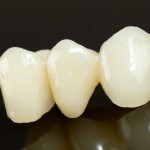
Fibre-reinforced composites (FRCs) have been used for a range of dental applications. One these their use in fixed partial dentures. They are formed from a fibre reinforced composite substructure and an overlay of resin veneering composite and may be surface or inlay retained. Fibre-reinforced composites fixed partial dentures (FRC-FPDs) could provide an alternative to conventional cast metal resin bonded bridges.
The aim of this review was to assess the longevity of FRC-FPDs, used to replace single anterior or posterior teeth
Methods
A search was conducted in Medline and the Web of Science. Two reviewers screened studies for inclusion. Randomised, and non-randomised, controlled, prospective and retrospective studies published in English between 2007 and 2015 were considered. Risk of bias was assessed using the Newcastle -Ottawa Scale. Survival period for each FPD was extracted along with the characteristics of the bridge design. Overall strength of evidence was assessed using the Strength of Recommendation Taxonomy (SORT) grading system
- Results
- 9 studies (3 prospective, 6 retrospective) were included.
- In all the studies included 592 FRC-FPDs placed in 463 patients.
- Follow up ranged from 2months – 8 years.
- 379 (64%) of the FRC-FPDs were placed on anterior teeth.
- 68% of FRC-FPDs were placed were placed in the Maxilla
- Reported survival rates: –
- Anterior FRC-FPDs ranged from 85.6-97.7% between 4.5 to 5 years.
- Posterior FRC-FPDs were 71.4% at 3 years dropping to 34% at 8 years
- Kaplan-Meier overall survival probability was calculated as 94.5% (95%CI; 92.5%-96.5%) at 4.8 years.
- Veneering material fracture/delamination occurred significantly more than other types of failures
- The overall quality of the evidence was considered to be moderate.
Conclusions
The authors concluded
Current clinical studies of FRC FPDs demonstrate high overall survival with predictable performance outcomes when used as a medium-term management alternative for replacing single anterior or posterior teeth in patients. Further research is required to identify the viability of FRC FPDs as a long-term treatment option.
Comments
While the authors have followed a structured process for this review they have only searched a limited number of databases and have only included English language studies so relevant references could have been excluded. Although the authors have assessed the overall grade of the evidence as moderate 75% of the included studies are retrospective in nature and are more susceptible to bias than prospective studies. The number of patients included in the individual studies was small ranging from 10 to 134 with 5 of the 9 included studies having 30 patients or fewer.
This review suggests good performance for FRC-FPDs for between 4-5 years . However, the quality of the available evidence means that the findings should be interpreted cautiously. For as the authors indicate ,data from well-designed and reported prospective studies of sufficient size are needed to clarify the outcomes and clinical performance of FRC-FPDs.
Links
Primary paper
Ahmed KE, Li KY, Murray CA. Longevity of fiber-reinforced composite fixed partial dentures (FRC FPD)-Systematic review. J Dent. 2016 Sep 3. pii:S0300-5712(16)30164-6. doi: 10.1016/j.jdent.2016.08.007. [Epub ahead of print] Review. PubMed PMID: 28356189.
Other references
Dental Elf- 7th Apr 2015 – Resin-bonded fixed dental prosthesis
